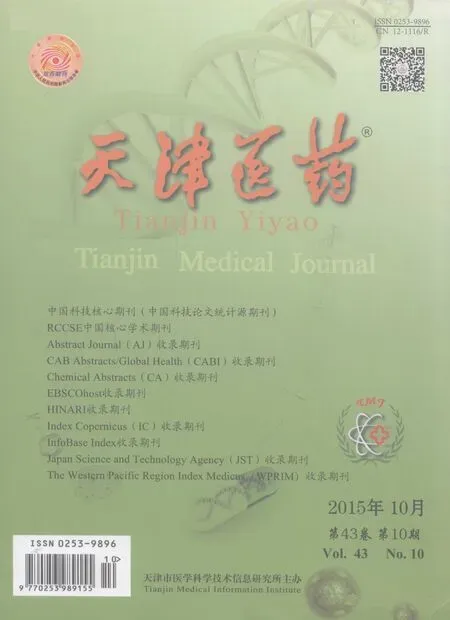IL-23/IL-17轴在强直性脊柱炎发病中的作用及治疗意义研究进展
陈超,李建军
IL-23/IL-17轴在强直性脊柱炎发病中的作用及治疗意义研究进展
陈超1,李建军2
强直性脊柱炎(AS)发病机制至今不明,治疗效果不佳。白细胞介素(IL)-23/IL-17轴是近几年受到高度重视的重要免疫通路。本文对IL-23/IL-17轴在AS发病遗传学和免疫学中的作用进行论述,并介绍了抗IL-23和抗IL-17抗体用于治疗AS的新进展。IL-23/IL-17轴在AS发病和治疗中的重要作用提示其可能成为一个有效的新治疗靶点。
脊柱炎,强直性;白细胞介素23;白细胞介素17;免疫疗法;综述;IL-23/IL-17轴
强直性脊柱炎(AS)致残率较高,发病年龄轻,进展迅速,晚期多形成脊柱和(或)髋、膝关节强直畸形,严重影响患者生活,而矫形手术难度大、风险高。AS治疗的重点在于早期行药物治疗,控制疼痛,延缓或终止病情进展,但目前临床尚无能达此要求的药物[1]。柳氮磺胺吡啶等传统药物起效慢、疗程长、不良反应多、依从性差,且不能很好地抑制疼痛,而肿瘤坏死因子(TNF)-α拮抗剂虽起效较快,但存在药效不足或病因针对性不强等缺点。白细胞介素(IL)-23/IL-17轴是近几年逐渐受到重视的重要免疫通路,在遗传学和免疫学方面均与AS有密切的关联,可能成为一个有效的新治疗靶点,本文对此作一综述。
1 IL-23/IL-17轴
IL-23/IL-17轴主要包括IL-23、IL-23受体(IL-23R)、信号传导子及转录激活子(STAT3)、蛋白酪氨酸激酶(JAK2)和IL-17等。IL-23/IL-17轴作用通路为:由树突状细胞、巨噬细胞和其他抗原提呈细胞分泌IL-23,IL-23与表达IL-23R的细胞特异性结合后,激活JAK2,磷酸化IL-23R的非连续位点,继而形成STAT3的停泊位点;随后STAT3被JAK2磷酸化,具备了二聚作用和转移至Th17细胞核的能力;在细胞核中,STAT3将上调维甲酸相关孤儿受体C(RORC),后者是重要的Th17细胞特异性转录调节因子,可促进IL-17的生成[2]。
2 IL-23/IL-17轴与AS发病的遗传学关联
Burton等[3]进行的全基因组关联研究(GWAS)显示,IL-23R基因多态性与AS易感性相关性很强。另有多项研究显示,白种人后裔人群均存在这一相关性[4-5]。但有研究显示,我国人群两者不存在这一关联性[6]。有针对东亚人群(中国、日本、韩国)进行的荟萃分析结果证实,与欧美人群的研究结果相反,IL-23R多态性与东亚人群AS易感性并无关联[7]。不过,该通路中另2个关键因子STAT3和(或)JAK2的基因变异与我国汉族人群AS发病相关[8-9]。这说明在基因层面上,由于遗传背景不同,不同种族人群之间AS的发病机制可能有所差异,但IL-23/IL-17轴在AS发病中起重要作用基本是共通的。
3 IL-23/IL-17轴在AS免疫学发病机制中的作用
3.1 IL-17的炎症破坏效应AS的早期病理特征是骶髂关节和肌腱、韧带的骨附着点处呈急性或慢性炎症,后期则进展为椎间盘炎和椎小关节炎;且AS患者均存在骨密度下降的现象。研究显示,AS患者外周血和椎小关节中Th17细胞数量及IL-17浓度均较健康者显著升高[10]。另有研究显示,IL-17在AS软骨下骨炎发病中起重要作用[11]。IL-17能激活巨噬细胞、树突状细胞、内皮细胞、成纤维细胞、软骨细胞以及成骨细胞等多种细胞,这些细胞将生成数量众多的致炎破坏性因子。在骨组织中,IL-17诱导成骨细胞表达细胞核因子κb受体活化因子配体(RANKL),激活破骨细胞,从而诱发骨吸收,累积性地加剧骨丢失,直接或间接地导致骨质破坏[12-13]。有研究显示,IL-17还能破坏关节软骨[14]。
3.2 IL-23/IL-23R影响IL-17的生成的机制IL-17主要由Th17细胞生成。Th17细胞分化中关键的细胞因子有IL-1β、IL-6、转化生长因子β(TGF-β)、IL-23、IL-21等。鼠类的Th17细胞是在IL-6和TGF-β存在的环境下,由幼稚的CD4(+)T细胞分化而来,然后在IL-21和IL-23的作用下快速成熟稳定[15]。实验性自身免疫性脑脊髓炎(EAE)和胶原诱导性关节炎(CIA)的模型研究显示,IL-23与Th17细胞的发育高度相关,缺乏IL-23的小鼠体内未生成IL-17的CD4(+)的T细胞[16]。早期的小鼠研究显示,IL-23能诱发IL-17的表达,辅助已分化的Th17细胞扩增和存活[17]。后期研究显示,IL-23R仅在激活的T细胞上表达,IL-23虽能上调Th17细胞的IL-17水平,但却不能使幼稚的T细胞向Th17细胞分化[18]。IL-23是Th17细胞发挥效应的必需因素而非分化所必需[19]。
Zeng等[20]研究发现,在感染环境中的脂多糖作用下,AS患者体外分离的巨噬细胞IL-23生成水平显著增高。目前,临床关于IL-23/IL-23R信号和AS的发病机制的关系研究尚无定论。有学者对此作出假设,即AS患者体内IL-23水平的变化和(或)IL-23R信号的改变导致了IL-17的生成增加[21]。目前,Th17细胞尚能在缺乏TGF-β的环境下联合应用IL-23和IL-6进行分化已达到临床共识。ROR-γt是Th17分化的一个重要的调节因子。在小鼠中,ROR-γt无论在体外还是体内均是IL-17表达的充分及必要条件;在人类,ROR-γt的人类直向同源物RORC是由IL-23、IL-1β和IL-6诱导,而这些细胞因子本身也可诱导IL-17的产生[20]。
IL-23是一种异二聚体结构的致炎因子,是IL-12家族的成员,IL-23和IL-12以及它们的受体之间存在很多结构上的共享现象[22]。IL-23由p19和p40两个亚基组成,其中的p40亚基与IL-12的p40亚基相同。IL-23和IL-12通过与各自的受体结合产生信号,它们的受体同样共用一个亚基IL-12Rβ1。IL-23R是IL-12Rβ1和IL-23R的一个异二聚体,而IL-12R则包含IL-12Rβ1和独特的IL-12Rβ2亚基。研究表明,IL-23和IL-1β能刺激IL-17的生成和表达[23]。
IL-23信号通路改变可导致AS患者IL-17应答增强。一方面,R381Q为IL-23R与AS相关的一个主要的保护性多态性,其能减弱AS对IL-23的应答,从而导致IL-17(+)的T细胞在带有R381Q的健康者中数量减少[24-25]。另一方面,HLA–B27(+)的AS患者体内表达杀伤细胞免疫球蛋白样受体3DL2(KIR-3DL2)的CD4(+)T细胞群增多,后者的集聚也是生成IL-17的重要一环[25]。
研究显示,IL-23可以增加IL-23R在Th17细胞上的表达[26]。AS患者外周血IL-23R阳性者的T细胞比例亦增高,IL-23R表达增加,体内γ/δ T细胞分泌的IL-17增多,γ/δ T细胞对IL-23的病理性应激反应增强,因而该研究认为,AS患者IL-23R表达的增加同时伴随着IL-17的生成增多[26]。
3.3 JAK2/STAT3的桥梁作用在Th17细胞的分化过程中,细胞因子的信号通过STAT3进行传导,从而启动种系特异性转录程序。STAT3对于Th17细胞的分化以及存活起重要的调节作用。JAK2则是STAT3磷酸化并转移至细胞核的必需因子。因此,有研究认为,抑制JAK2将极大程度减少STAT3的磷酸化[27]。
STAT3可直接与IL-17A、IL-17F以及IL-21基因座结合并对各基因进行调控,从而调节ROR-γt和IL-23R的表达[28]。首先,IL-17A/F基因具有公认的STAT结合位点,STAT3能直接与这一启动子结合。其次,IL-6、IL-21和IL-23均能够激活Janus激酶家族并优先激活STAT3,而IL-6介导的IL-21的生成是依赖于STAT3的,STAT3能与IL-21启动子结合。第三,STAT3在ROR-γt的表达中起重要作用,后者是Th17分化所需的一个关键的转录因子。杂合的STAT3基因变异能使功能性STAT3二聚体的利用率降低25%,相应地可使ROR-γt的表达减少4倍[29]。最后,IL-6、IL-21和IL-23能够上调IL-23R的表达,而这也是STAT3依赖性的。
最近的一项研究显示,STAT3的变异可对人Th17细胞的发育造成损害,STAT3缺如的T细胞在体外分化为Th17细胞的能力极大地受损;Th17细胞优先表达ROR-γt,而表达该转录因子的功能在缺乏STAT3的T细胞中同样受损;相反地,逆转录病毒过度表达激活的STAT3将导致IL-17生成增加[30]。
4 IL-23/IL-17轴对于AS的治疗意义
4.1 抗IL-23抗体目前有关抗IL-23抗体用于AS临床治疗方面的研究少见。有体外实验表明,抗IL-23抗体能阻断IL-23/IL-17轴,抑制IL-23介导的IL-17的产生[31]。Chen等[32]报道,抗IL-23抗体能抑制多种炎症通路,改善EAE的症
状。特异性阻断IL-23免疫通路能安全有效地治疗包括系统性红斑狼疮(SLE)在内的多种自身免疫性炎症疾病[33]。
由于IL-23与IL-12共享p40亚基,因此,以往针对IL-12p40的抗体也逐渐开始应用于IL-23相关疾病的治疗研究中。注射抗p40抗体阻断IL-23和IL-12的活性已被证明有效可行,IL-23受体拮抗剂在多种免疫性疾病的临床应用阶段或临床前阶段的研究已深入开展[34]。
Ustekinumab是近年来研究广泛的一种抗IL-12的单克隆抗体,它通过与p40亚基结合,阻止IL-12与IL-12受体复合体的IL-12β1链结合,继而达到中和IL-12的作用。通过与IL-23和IL-12共有的p40亚基结合,ustekinumab也能阻止IL-23与IL-23受体复合体的IL-12β1链的结合,从而发挥类似的中和IL-23生物活性的作用。研究显示,ustekinumab以细胞因子∶抗体为2∶1的比例结合于IL-12/ 23 p40亚基上的1号结构域[34]。因此,笔者认为,ustekinum⁃ab这种既能与IL-12也能与IL-23的p40亚基结合的能力是其能同时中和IL-12和IL-23生物活性的基础所在。
Ustekinumab的研发最初是用于治疗银屑病,但对其他免疫介导的炎症性疾病也可能有效。Ustekinumab能阻断IL-12/IL-23与它们的受体之间的相互作用,进而阻断它们之间的信号传导、分化和细胞因子的生成。研究表明,Th17通路失调与多种疾病[包括风湿类疾病[35],如类风湿性关节炎、银屑病关节炎(PsA);胃肠疾病[36],如克罗恩病(CD)、溃疡性结肠炎等]之间均存在因果关联[37]。2009年,Ustekinumab获得美国食品药品监督管理局(FDA)和欧洲药品局(EMA)批准上市,用于治疗非皮肤病损疾病如CD[38]。目前,有关ustekinumab治疗AS的研究报道尚少见。除ustekinumab外,另一种作用于相同分子的生物制剂briakinumab(ABT-874)目前还处于治疗银屑病的申请批准阶段[39]。
4.2 抗IL-17抗体抗IL-17抗体用于AS的治疗已有相关研究。目前的抗IL-17抗体命名为secukinumab(AIN-457),是一种完全的人类IgG1单克隆抗体,能中和IL-17的效应。最近欧洲的一项研究显示,经脊柱关节病国际学会评估表(ASAS)评估,secukinumab治疗重度AS患者有效率可达61%,而安慰剂对照组仅为17%[39]。MRI显示,secukinum⁃ab减轻脊柱炎症的效果最早在第6周即可出现[40]。因此,IL-17抗体的应用研发前景值得期待。
综上所述,IL-23/IL-17轴在AS发病和进展过程中的重要作用已基本确认,但作用机制仍不明,临床治疗意义仍在探讨中。由于IL-23/IL-17轴包含若干因子,今后开发每种因子的拮抗剂是否能有效缓解病情,甚至几种因子的拮抗剂组成的合成药物是否可以明显减轻AS的临床症状尚有待研究深入。
[1]Smith JA.Update on ankylosing spondylitis:current concepts in pathogenesis[J].Curr Allergy Asthma Rep,2015,15(1):489.doi: 10.1007/s11882-014-0489-6.
[2]Yeremenko N,Paramarta JE,Baeten D.The interleukin-23/inter⁃leukin-17 immune axis as a promising new target in the treatment of spondyloarthritis[J].Curr Opin Rheumatol,2014,26(4):361-370. doi:10.1097/BOR.0000000000000069.
[3]Burton PR,Clayton DG,Cardon LR,et al.Association scan of 14, 500 nonsynonymous SNPs in four diseases identifies autoimmunity variants[J].Nat Genet,2007,39(11):1329-1337.
[4]Karaderi T,Harvey D,Farrar C,et al.Association between the inter⁃leukin 23 receptor and ankylosing spondylitis is confirmed by a new UK case-control study and meta-analysis of published series[J]. Rheumatology(Oxford),2009,48(4):386-389.doi:10.1093/rheuma⁃tology/ken501.Epub 2009 Feb 2.
[5]Rueda B,Orozco G,Raya E,et al.The IL23R Arg381Gln non-syn⁃onymous polymorphism confers susceptibility to ankylosing spondy⁃litis[J].Ann Rheum Dis,2008,67(10):1451-1454.doi:10.1136/ ard.2007.080283.
[6]Qian BP,Jiang J,Ji ML,et al.Lack of associations between two pre⁃viously identified susceptible single nucleotide polymorphisms of in⁃terleukin-23 receptor gene and ankylosing spondylitis:a replica⁃tion study in a Chinese Han population[J].BMC Musculoskelet Dis⁃ord,2013,14:190.doi:10.1186/1471-2474-14-190.
[7]Chen C,Zhang X,Li J,et al.Associations of IL-23R polymor⁃phisms with ankylosing spondylitis in East Asian population:a new case-control study and a meta-analysis[J].Int J Immunogenet, 2012,39(2):126-130.doi:10.1111/j.1744-313X.2011.01067.x.
[8]Chen C,Zhang X,Wang Y.Analysis of JAK2 and STAT3 polymor⁃phisms in patients with ankylosing spondylitis in Chinese Han pop⁃ulation[J].Clin Immunol,2010,136(3):442-446.doi:10.1016/j. clim.2010.05.003.
[9]Davidson SI,Liu Y,Danoy PA,et al.Association of STAT3 and TN⁃FRSF1A with ankylosing spondylitis in Han Chinese[J].Ann Rheum Dis,2011,70(2):289-292.doi:10.1136/ard.2010.133322.
[10]Shen H,Goodall JC,Hill GJS.Frequency and phenotype of periph⁃eral blood Th17 cells in ankylosing spondylitis and rheumatoid ar⁃thritis[J].Arthritis Rheum,2009,60(6):1647-1656.doi:10.1002/ art.24568.
[11]Prevosto C,Goodall JC,Hill GJS.Cytokine secretion by pathogen recognition receptor-stimulated dendritic cells in rheumatoid arthri⁃tis and ankylosing spondylitis[J].J Rheumatol,2012,39(10):1918-1928.doi:10.3899/jrheum.120208.
[12]Kotake S,Yago T,Kawamoto M,et al.Role of osteoclasts and inter⁃leukin-17 in the pathogenesis of rheumatoid arthritis:crucial'hu⁃man osteoclastology'[J].J Bone Miner Metab,2012,30(2):125-135. doi:10.1007/s00774-011-0321-5.
[13]Gaffen SL.The role of interleukin-17 in the pathogenesis of rheu⁃matoid arthritis[J].Curr Rheumatol Rep,2009,11(5):365-370.
[14]Ebihara S,Date F,Dong Y,et al.Interleukin-17 is a critical target for the treatment of ankylosing enthesitis and psoriasis-like dermati⁃tis in mice[J].Autoimmunity,2015,48(4):259-266.doi:10.3109/ 08916934.2014.976630.
[15]Tesmer LA,Lundy SK,Sarkar S,et al.Th17 cells in human disease[J].ImmunolRev,2008,223:87-113.doi:10.1111/j.1600-065X.2008.00628.x.
[16]Kreymborg K,Bohlmann U,Becher B.IL-23:changing the verdict on IL-12 function in inflammation and autoimmunity[J].Expert Opin Ther Targets,2005,9(6):1123-1136.
[17]Harrington LE,Hatton RD,Mangan PR,et al.Interleukin 17-pro⁃
ducing CD41 effector T cells develop via a lineage distinct from the T helper type 1 and 2 lineages[J].Nat Immunol,2005,6(11):1123-1132.
[18]Aggarwal S,Ghilardi N,Xie MH,et al.Interleukin-23 promotes a distinct CD4 T cell activation state characterized by the production of interleukin-17[J].J Biol Chem,2003,278(3):1910-1914.
[19]Cornelissen F,van Hamburg JP,Lubberts E.The IL-12/IL-23 axis and its role in Th17 cell development,pathology and plasticity in ar⁃thritis[J].Curr Opin Investig Drugs,2009,10(5):452-462.
[20]Zeng L,Lindstrom MJ,Smith JA.Ankylosing spondylitis macro⁃phage production of higher levels of interleukin-23 in response to li⁃popolysaccharide without induction of a significant unfolded protein response[J].ArthritisRheum,2011,63(12):3807-3817.doi: 10.1002/art.30593.
[21]Gaston JS,Goodall JC,Baeten D.Interleukin-23:a central cytokine in the pathogenesis of spondylarthritis[J].Arthritis Rheum,2011,63(12):3668-3671.doi:10.1002/art.30600.
[22]Trinchieri G,Pflanz S,Kastelein RA.The IL-12 family of heterodi⁃meric cytokines:new players in the regulation of T cell responses[J].Immunity,2003,19(5):641-644.
[23]Abraham C,Cho JH.IL-23 and autoimmunity:new insights into the pathogenesis of inflammatory bowel disease[J].Annu Rev Med, 2009,60:97-110.doi:10.1146/annurev.med.60.051407.123757.
[24]Di MP,Di CA,Laggner U,et al.The IL23R R381Q gene variant protects against immune-mediated diseases by impairing IL-23-in⁃duced Th17 effector response in humans[J].PLoS One,2011,6(2): e17160.doi:10.1371/journal.pone.0017160.
[25]Sarin R,Wu X,Abraham C.Inflammatory disease protective R381Q IL23 receptor polymorphism results in decreased primary CD4+and CD8+human T-cell functional responses[J].Proc Natl AcadSciUSA,2011,108(23):9560-9565.doi:10.1073/ pnas.1017854108.
[26]Che MNF,Zhang X,Guzzo C,et al.Interleukin-23-induced inter⁃leukin-23 receptor subunit expression is mediated by the Janus ki⁃nase/signal transducer and activation of transcription pathway in hu⁃man CD4 T cells[J].J Interferon Cytokine Res,2011,31(4):363-371.doi:10.1089/jir.2010.0083.
[27]Saleh A,Shan L,Halayko AJ,et al.Critical role for STAT3 in IL-17A-mediated CCL11 expression in human airway smooth muscle cells[J].J Immunol,2009,182(6):3357-3365.doi:10.4049/jimmu⁃nol.0801882.
[28]Egwuagu CE.STAT3 in CD4+T helper cell differentiation and in⁃flammatorydiseases[J].Cytokine,2009,47(3):149-156.doi: 10.1016/j.cyto.2009.07.003.
[29]Fischer A.Human immunodeficiency:connecting STAT3,Th17 and human mucosal immunity[J].Immunol Cell Biol,2008,86(7):549-551.doi:10.1038/icb.2008.52.
[30]Kenna TJ,Davidson SI,Duan R,et al.Enrichment of circulating in⁃terleukin-17-secreting interleukin-23 receptor-positive gamma/ delta T cells in patients with active ankylosing spondylitis[J].Arthri⁃tis Rheum,2012,64(5):1420-1429.doi:10.1002/art.33507.
[31]Cao H,Lan Q,Shi Q,et al.Anti-IL-23 antibody blockade of IL-23/ IL-17 pathway attenuates airway obliteration in rat orthotopic tra⁃cheal transplantation[J].Int Immunopharmacol,2011,11(5):569-575.doi:10.1016/j.intimp.2010.11.007.
[32]Chen SJ,Wang YL,Lo WT,et al.Erythropoietin enhances endoge⁃nous haem oxygenase-1 and represses immune responses to amelio⁃rate experimental autoimmune encephalomyelitis[J].Clin Exp Im⁃munol,2010,162(2):201-213.
[33]Leng RX,Pan HF,Chen GM,et al.IL-23:a promising therapeutic target for systemic lupus erythematosus[J].Arch Med Res,2010,41(3):221-225.doi:10.1016/j.arcmed.2010.02.011.
[34]Luo J,Wu SJ,Lacy ER,et al.Structural basis for the dual recogni⁃tion of IL-12 and IL-23 by ustekinumab[J].J Mol Bio,2010,402(5):797-812.doi:10.1016/j.jmb.2010.07.046.
[35]Murphy CA,Langrish CL,Chen Y,et al.Divergent pro-and antiin⁃flammatory roles for IL-23 and IL-12 in joint autoimmune inflam⁃mation[J].J Exp Med,2003,198(12):1951-1957.
[36]Rong G,Zhou Y,Xiong Y,et al.Imbalance between T helper type 17 and T regulatory cells in patients with primary biliary cirrhosis: the serum cytokine profile and peripheral cell population[J].Clin Exp Immunol,2009,156(2):217-225.doi:10.1111/j.1365-2249.2009.03898.x.
[37]Yeilding N,Szapary P,Brodmerkel C,et al.Development of the IL-12/23 antagonist ustekinumab in psoriasis:past,present,and future perspectives--an update[J].Ann N Y Acad Sci,2012,1263:1-12. doi:10.1111/j.1749-6632.2012.06670.x.
[38]Kurzeja M,Rudnicka L,Olszewska M.New interleukin-23 pathway inhibitorsindermatology:ustekinumab,briakinumab,and secukinumab[J].Am J Clin Dermatol,2011,12(2):113-125.doi: 10.2165/11538950-000000000-00000.
[39]Baeten D,Baraliakos X,Braun J,et al.Anti-interleukin-17A mono⁃clonal antibody secukinumab in treatment of ankylosing spondylitis:a randomised,double-blind,placebo-controlled trial[J].Lancet,2013, 382(9906):1705-1713.doi:10.1016/S0140-6736(13)61134-4.
[40]Toussirot E.The IL23/Th17 pathway as a therapeutic target in chronic inflammatory diseases[J].Inflamm Allergy Drug Targets, 2012,11(2):159-168.
(2015-01-30收稿 2015-05-12修回)
(本文编辑 陆荣展)
Roles of IL-23/IL-17 axis in pathogenesis and treatment of ankylosing spondylitis
CHEN Chao1,LI Jianjun2
1 Department of Spine Surgery,Tianjin Hospital,Tianjin 300233,China;2 Beijing Bo Ai Hospital,China Rehabilitation Research Center
The treatments for ankylosing spondylitis(AS)are still not effective,which partially due to its unclear patho⁃genesis.Interleukin(IL)-23/IL-17 axis is a significant immunologic pathway which has attracted much attention in the past few years.This article reviewed the role of IL-23/IL-17 axis in genetic and immunological pathogenesis of AS,and intro⁃duced the recent progresses in treatments of AS using anti-IL-23 or anti-IL-17 antibody.The important role of IL-23/IL-17 axis in the pathogenesis and treatment of AS indicates its potential use as a new therapeutic target.
spondylitis,ankylosing;interleukin-23;interleukin-17;immunotherapy;review;IL-23/IL-17 axis
R593.23
A
10.11958/j.issn.0253-9896.2015.10.034
北京市博士后A类经费资助课题(2011ZZ-02);中国康复研究中心科研基金面上课题(2011-24)
1天津,天津医院脊柱外科(邮编300233);2中国康复研究中心北京博爱医院
陈超(1981),男,主治医师,博士后,主要从事脊柱外科研究

